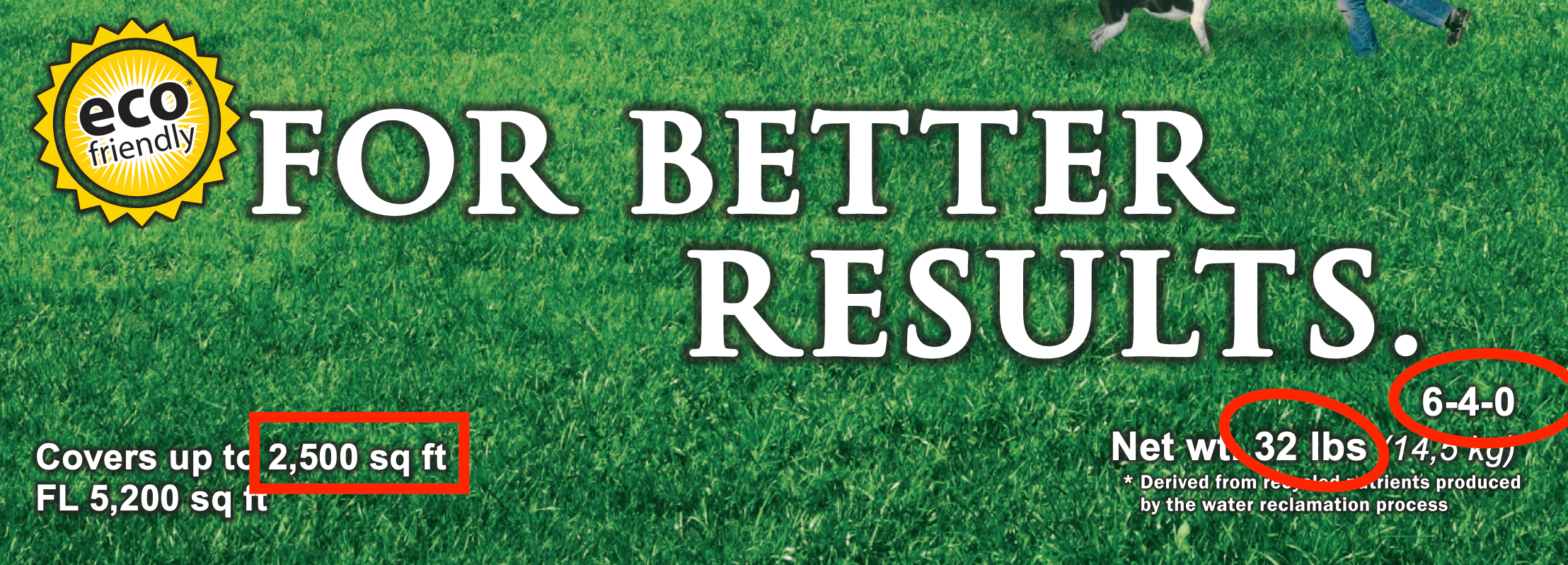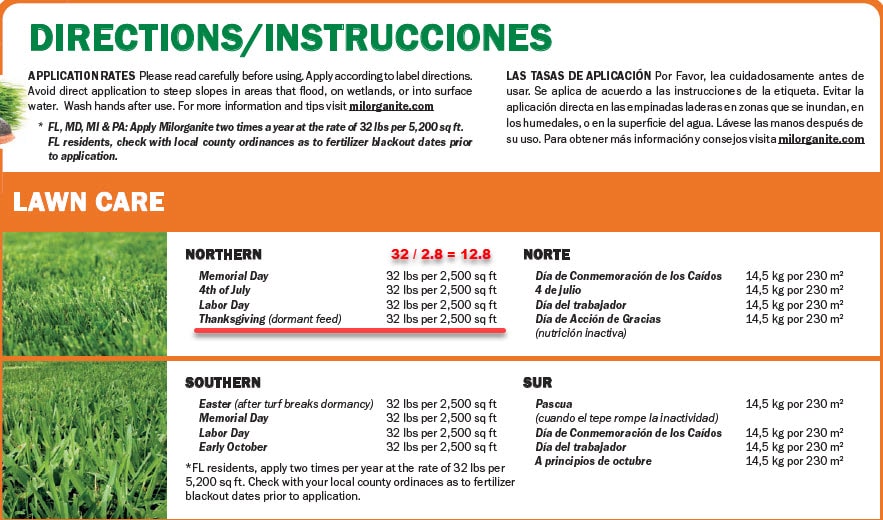Can You Use Milorganite as a Winterizer Lawn Fertilizer?
- "The Lawn Care Nut"November 9, 2024
Here we are my friends: Autumn.
If you are up north the leaves have changed and are falling and you’re working on cleaning them up! Hot apple cider, a good cigar and the smell of burning leaves in the air. That’s a fall evening!
If you have a cool season lawn (Kentucky Bluegrass, turf type tall fescue or perennial ryegrass) then a winterizer treatment is a great idea, especially if you want to have the greenest lawn the earliest next spring! That’s really what it’s all about for me is jumping out greener than the neighbors early next season. I grab the lead early and hold it all season and a winterizer in the season before is the key.
Talking about winterizers also gives me an opportunity to review the lawn care math with you and talk about “pounds on the ground” of nitrogen. You all know I love the math and my goal is to get you to love it too! Let’s push it!
Fall Nitrogen Push
To give you some context, my strategies for cool season turf focus on pushing nitrogen in the fall time. Not only is the fall time the best time to get your lawn deep green in color, it’s also the ideal time to thicken it up and fill in thin spots that may have developed during the long summer

That’s because cool-season grasses have a natural growth surge in fall, and pushing it with nitrogen encourages it to do more of what it’s doing already! The more growth, the thicker it gets, the thin and dead spots disappear!
Many of you may have seeded your lawns back in September, and here we are 2 months later, and you’ve got a nice stand of turf growing. Nitrogen will help drive more growth and get it ready for winter so that next spring it’s lush and full, ready to compete with the onslaught of spring dandelions.
Existing lawns and newly seeded lawns can be pushed with nitrogen all during the fall season. If you are far north, you may be nearing the end of this fall push, often times called the “nitrogen blitz,” but those of you further south growing tall fescue in Carolinas or Southern Indiana - you have some decent growing season left and can keep on spreading ¾ lbs. / N/ 1,000 sq ft every month. If you are mowing, then you can be throwing. It’s just that simple.
There is going to come a point though, where the lawn stops growing. It may still be somewhat green, but won’t need to be mowed anymore. When I lived in NW Indiana (on Lake Michigan) that time was usually correlated with the week after Thanksgiving. I can remember putting up Christmas lights on Black Friday and looking down at my lawn. It wasn’t growing, I wasn’t mowing, but the soil was not yet frozen. That is key.
The best time to apply your winterizer is after the lawn has stopped growing but the ground is not yet frozen. If you like to follow the soil temperature model that I teach, then the best soil temp is 40F. When your soil temps hit 40F, drop your winterizer and you’re good to go until next season. Check out this online tool to learn your current soil temperature.

Milorganite has language on the label about this last feeding of the season too. It’s referred to as a “dormant feed” and the bag coverage indicates 32 lbs. per 2,500 sq ft.
Now here comes the fun math!
Milorganite has an analysis of 6-4-0. The first number is the one I care about most and that is nitrogen. That number 6 indicates that 6% of the product contained in the bag is nitrogen. The 4 indicates the phosphorus content which in this case is 4%. Those are the two primary macros included in Milorganite: Nitrogen and Phosphorus. It’s also got Calcium (1.2%) and iron (2.5%). Keep in mind, it’s nitrogen that we care most about. Nitrogen drives the bus.
Note: I talked all about nitrogen above, but the phosphorus in Milo is also great for rooting. This time of year, cool season turf grows root mass just like it does top tissue. Phosphorus is great for increased rooting.
A Lawn Care Standard
In lawn care, we almost always break things down into increments of 1,000 sq ft. It’s kind of like our base measurement and it’s how we communicate about “how much” of a product to apply. In the case of Milorganite, we know that 32 lbs. cover 2,500 sq ft which translates to an application rate or “bag rate” of 12.8 lbs. / 1,000 sq ft.

The suggested application rate for the fall dormant feed treatment of Milorganite is 12.8 lbs./ 1,000 sq ft. Since we know that 6% of everything we apply is nitrogen that means that we are applying ¾ lbs. of nitrogen for each 1,000 sq ft of lawn area.
If you hang out around the lawn community either on FaceBook, or maybe Reddit or Discord, you will see people referring to their nitrogen “pounds on the ground.”
Above in referring to my nitrogen blitz strategy, I said “you have some decent growing season left and can keep on spreading ¾ lbs. / N/ 1,000 sq ft every month. If you are mowing, then you can be throwing.”
In discussing this concept on social media sites, another person might say “I apply 1 lb. of nitrogen monthly and blitz my lawn in the spring and fall to really push growth.”
Someone who really likes to be out in the lawn may choose a more frequent feeding schedule and say something such as, “I like to spoon feed my lawn ¼ lb. of nitrogen weekly in the fall for my blitz.”
When you see or hear people talking like this, they are referring to the literal “pounds on the ground” of nitrogen and as I stated, in lawn care, we always speak in increments of 1,000 sq ft.
Nitrogen drives the bus. It’s what makes the lawn green and it’s what makes it grow. It’s what we talk about most.
If you read university websites, they speak in similar terms. In this article, Purdue University recommends: “A good rule to follow is to never apply more than 1.0 lb. N/1000ft2 in any one application.”
What they are saying is that for a single application to cool season turf, it’s recommended to apply no more than 1lb. of nitrogen per 1,000 sq. ft.”
How does the Milorganite label recommendation stack up to all this nitrogen talk?
The fall dormant application of Milorganite is going to give us ¾ lbs. of nitrogen. Here’s the breakdown:
- Bag Weight: 32 lbs
- Coverage: 2,500 sq ft
- App Rate: 12.8 lbs / 1,000 sq ft
Analysis: 6-4-0
- 12.8 x .06 = .75
- ¾ lbs. / N / 1,000 sq ft
That’s a good application rate and plenty of nitrogen to give you a nice push next spring. Keep in mind, this dormant feed/winterizer isn’t for the turf to utilize now. We want it to settle into the canopy and sit there under the snow all winter. Once things start to warm up in spring and the microbial activity kicks up again, the Milo will be utilized by the turf for an early green-up, before everyone else in the neighborhood.
That’s another great thing about Milo - it’s derived from organic sources that naturally breaks down slowly as the soil warms up and the microbes start their work. This is very important for spring because the lawn is also waking up slowly and won’t be able to use all the nitrogen right away. It will want it slowly over the first several weeks and the slow release nature of Milo fits this requirement perfectly.
So put down the cigar and the cider, blow off the rest of the leaves, and get out and sling that Milo one last time this season, you’re in the window, it’s time, let’s go!
I’ll see you in the lawn!

